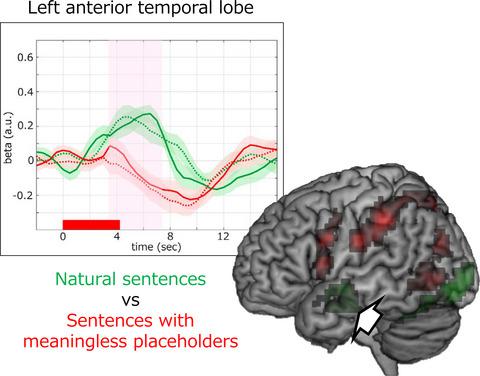当前位置:
X-MOL 学术
›
Eur. J. Neurosci.
›
论文详情
Our official English website, www.x-mol.net, welcomes your
feedback! (Note: you will need to create a separate account there.)
When a sentence loses semantics: Selective involvement of a left anterior temporal subregion in semantic processing
European Journal of Neuroscience ( IF 2.7 ) Pub Date : 2020-10-26 , DOI: 10.1111/ejn.15022 Toshiki Iwabuchi 1 , Michiru Makuuchi 1
European Journal of Neuroscience ( IF 2.7 ) Pub Date : 2020-10-26 , DOI: 10.1111/ejn.15022 Toshiki Iwabuchi 1 , Michiru Makuuchi 1
Affiliation

|
Although the left anterior temporal lobe (ATL) has been associated with semantic processing, the role of this region in syntactic structure building of sentences remains a subject of debate. Functional neuroimaging studies contrasting well‐formed sentences with word lists lacking syntactic structure have produced mixed results. The current functional magnetic resonance imaging study examined whether the left ATL is selectively involved in semantic processing or also plays a role in syntactic structure building by manipulating syntactic complexity and meaningfulness in a novel way. To deprive semantic/pragmatic information from a sentence, we replaced all content words with pronounceable meaningless placeholders. We conducted an experiment with a 2 × 2 factorial design with factors of SEMANTICS (natural sentences [NAT]; sentences with placeholders [SPH]) and SYNTAX (the basic Japanese Subject‐Object‐Verb [SOV] word order; a changed Object‐Subject‐Verb [OSV] word order). A main effect of SEMANTICS (NAT > SPH) was found in the left ATL, as well as in the ventral occipitotemporal regions. The opposite contrast (SPH > NAT) revealed activation in the dorsal regions encompassing Brodmann area 44, the premotor area, and the parietal cortex in the left hemisphere. We found no main effect of SYNTAX (OSV > SOV) in a subregion of the left ATL that was more responsive to natural sentences than meaningless sentences. These results indicate selective involvement of a subregion of the left ATL in semantic/pragmatic processing.
中文翻译:

当句子失去语义时:左前颞区在语义处理中的选择性参与
尽管左前颞叶(ATL)已与语义处理相关联,但该区域在句子的句法结构构建中的作用仍是争论的主题。功能神经影像学研究将格式良好的句子与缺乏句法结构的单词列表进行对比,结果却不尽相同。当前的功能磁共振成像研究检查了左ATL是否选择性地参与语义处理,还是通过以新颖的方式操纵语法的复杂性和意义来在语法结构的构建中发挥作用。为了剥夺句子中的语义/语用信息,我们用明显无意义的占位符替换了所有内容词。我们进行了一个采用SEMANTICS因子(自然句[NAT];具有占位符[SPH]的句子和SYNTAX(基本的日语主语-宾语[SOV]单词顺序;更改的宾语-主语-动词[OSV]单词顺序)。SEMANTICS(NAT> SPH)的主要作用是在左ATL以及腹枕颞叶区域中发现的。相反的对比(SPH> NAT)显示了在包括Brodmann区域44,运动前区域和左半球顶叶皮质的背侧区域的激活。我们发现在左ATL的一个子区域中,SYNTAX(OSV> SOV)的主要作用没有发生,而对自然句子的响应要比无意义的句子要大。这些结果表明左ATL的子区域在语义/语用处理中的选择性参与。SEMANTICS(NAT> SPH)的主要作用是在左ATL以及腹枕颞叶区域中发现的。相反的对比(SPH> NAT)显示了在包括Brodmann区域44,运动前区域和左半球顶叶皮质的背侧区域的激活。我们发现在左ATL的一个子区域中,SYNTAX(OSV> SOV)的主要作用没有发生,而对自然句子的响应要比无意义的句子要大。这些结果表明左ATL的子区域在语义/语用处理中的选择性参与。SEMANTICS(NAT> SPH)的主要作用是在左ATL以及腹枕颞叶区域中发现的。相反的对比(SPH> NAT)显示了在包括Brodmann区域44,运动前区域和左半球顶叶皮质的背侧区域的激活。我们发现在左ATL的一个子区域中,SYNTAX(OSV> SOV)的主要作用没有发生,而对自然句子的响应要比无意义的句子要大。这些结果表明左ATL的子区域在语义/语用处理中的选择性参与。我们发现在左ATL的一个子区域中,SYNTAX(OSV> SOV)的主要作用没有发生,而对自然句子的响应要比无意义的句子要大。这些结果表明左ATL的子区域在语义/语用处理中的选择性参与。我们发现在左ATL的一个子区域中,SYNTAX(OSV> SOV)的主要作用没有发生,而对自然句子的响应要比无意义的句子要大。这些结果表明左ATL的子区域在语义/语用处理中的选择性参与。
更新日期:2020-10-26
中文翻译:

当句子失去语义时:左前颞区在语义处理中的选择性参与
尽管左前颞叶(ATL)已与语义处理相关联,但该区域在句子的句法结构构建中的作用仍是争论的主题。功能神经影像学研究将格式良好的句子与缺乏句法结构的单词列表进行对比,结果却不尽相同。当前的功能磁共振成像研究检查了左ATL是否选择性地参与语义处理,还是通过以新颖的方式操纵语法的复杂性和意义来在语法结构的构建中发挥作用。为了剥夺句子中的语义/语用信息,我们用明显无意义的占位符替换了所有内容词。我们进行了一个采用SEMANTICS因子(自然句[NAT];具有占位符[SPH]的句子和SYNTAX(基本的日语主语-宾语[SOV]单词顺序;更改的宾语-主语-动词[OSV]单词顺序)。SEMANTICS(NAT> SPH)的主要作用是在左ATL以及腹枕颞叶区域中发现的。相反的对比(SPH> NAT)显示了在包括Brodmann区域44,运动前区域和左半球顶叶皮质的背侧区域的激活。我们发现在左ATL的一个子区域中,SYNTAX(OSV> SOV)的主要作用没有发生,而对自然句子的响应要比无意义的句子要大。这些结果表明左ATL的子区域在语义/语用处理中的选择性参与。SEMANTICS(NAT> SPH)的主要作用是在左ATL以及腹枕颞叶区域中发现的。相反的对比(SPH> NAT)显示了在包括Brodmann区域44,运动前区域和左半球顶叶皮质的背侧区域的激活。我们发现在左ATL的一个子区域中,SYNTAX(OSV> SOV)的主要作用没有发生,而对自然句子的响应要比无意义的句子要大。这些结果表明左ATL的子区域在语义/语用处理中的选择性参与。SEMANTICS(NAT> SPH)的主要作用是在左ATL以及腹枕颞叶区域中发现的。相反的对比(SPH> NAT)显示了在包括Brodmann区域44,运动前区域和左半球顶叶皮质的背侧区域的激活。我们发现在左ATL的一个子区域中,SYNTAX(OSV> SOV)的主要作用没有发生,而对自然句子的响应要比无意义的句子要大。这些结果表明左ATL的子区域在语义/语用处理中的选择性参与。我们发现在左ATL的一个子区域中,SYNTAX(OSV> SOV)的主要作用没有发生,而对自然句子的响应要比无意义的句子要大。这些结果表明左ATL的子区域在语义/语用处理中的选择性参与。我们发现在左ATL的一个子区域中,SYNTAX(OSV> SOV)的主要作用没有发生,而对自然句子的响应要比无意义的句子要大。这些结果表明左ATL的子区域在语义/语用处理中的选择性参与。











































 京公网安备 11010802027423号
京公网安备 11010802027423号